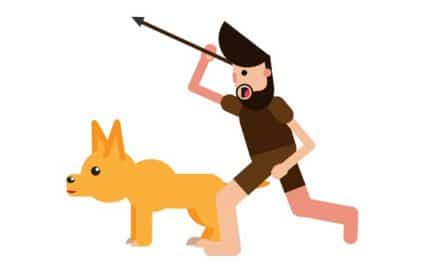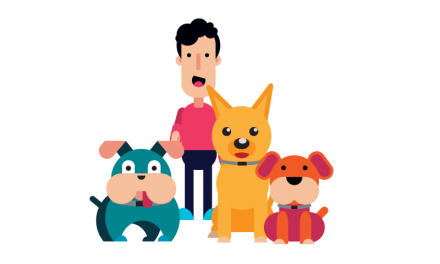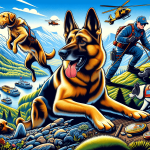Understanding dog body language
Understanding dog body language is extremely helpful when communicating with your dog. Like us, dogs communicate their moods through postures, and when we can understand those postures, we can finally understand what a dog is doing and why it’s doing it.

A lot of dog postures communicate desires, moods, and ranks. They’re easily interpreted by canines, but not people. We may for example misinterpret a wagging tail as a sign of friendliness when it could mean a dog is scared and doesn’t want you to hurt it, or it could mean that the dog will bite you if you continue toward it or its territory.
The best way to interpret dog body language is to observe all of its body parts: the facial expression, the stand, the tail, the wrinkles… everything. You can’t depend on just one part to fully interpret a message especially if you’re dealing with a dog with a docked tail or curly tail for example.
In general, a happy dog that’s eager to play will lean forward and rapidly wag its tail. (If the dog is simply glad to see you, it will wag its tail in a slower fashion.) It may also bark a few times, bow, jump, or let out a playful growl. You can discern a playful growl and bark from a warning growl bark via pitch. A dog’s playful sounds are emitted at a higher pitch than its serious ones, which consequently communicate aggressiveness or irritation. If a dog smiles, you’ll recognize it by seeing a slightly opened mouth that barely exposes teeth. The only wrinkles you’ll see on a smile are wrinkles near the corners of the mouth, and the rest of the face is relaxed.
When a dog is afraid, it tries to minimize its size. It will lean back, crouch, and look away. A frightened dog’s tail points down or it’s placed between its legs. It may also lick its lips, expose its belly, or pee. But just because a dog is afraid, that doesn’t mean it will stay that way. A dog has a fight or flight instinct just like a human has, and it may attack if it doesn’t have an opportunity to flee (especially if it’s on a leash). This is what can make fearful dogs more aggressive (and dangerous) than dominant dogs.
When a dog is alert, it tenses its muscles, points its ears up and forward, and it slightly wrinkles its face. It may also point its tail up or parallel to the ground and wag it very slow, sometimes keeping it still in-between wags. The hackles on an alert dog may rise as well. An alert dog isn’t anything to be too concerned about. This is a response all dogs exhibit when they’re listening to unfamiliar sounds. The only thing to watch for is a sudden leap into aggressive behavior, indicated by low growls and teeth bearing. Right before a dog becomes aggressive, it’s in an alert state.
A dog that’s both dominant and aggressive will make itself look bigger than it really is by leaning forward, bearing teeth, raise its hackles and wrinkling its face. Its ears also point forward and its tail wags very slowly as the dog issues an intense stare. If you see hair raised along a dog’s back (hackles), the dog is either afraid or aggressive. Hackles aren’t easily seen on dogs with long hair or dogs that have natural hackles (like the Rhodesian ridgeback or Thai ridgeback). That’s why you need to look for additional cues.
Body position, exposed teeth, the number of wrinkles surrounding the mouth, and ear position are good tools to use when trying to interpret the intentions of a dog. A dog will show its teeth for example when it’s afraid, aggressive, hunting prey, or simply playing. The more teeth and gum you see, the more aggression you should expect. Of course, the less teeth and gum you see, the less aggression you can expect. If you see a only small portion of teeth, it could be a warning though and you really have to look at other cues.
The dog smile bears teeth, but not very many of them. It accompanies lowered eyes, a wagging tail, hanging tongue, and a few mouth wrinkles. If you see a lot of wrinkles around the mouth and on the nose, you’re not looking at a smile at all. You’re looking at a grimace instead that may indicate agitation, fear, or aggressiveness.
The following cues will help you correctly interpret your dog’s mood:
Body
- A sulking low body crouched to the ground indicates submission, fear, or fear-aggressiveness.
- A standing, raised, and forward leaning body indicates aggressive or predatory excitement.
- A front-leg extended bow with head down and air-borne rum indicates a desire to play or get some attention
- A belly exposed body laid on the back indicates submission or fear.
Ears
- Fully lifted, open, forward facing ears indicate high interest.
- Partly lifted, open, forward facing ears indicate a pending interest.
- Halfway lifted, open, sideways facing ears indicate a worried interest.
- Lowered, downward or backward facing ears indicate worry and a desire to leave.
- Lowered ears that are plastered to the head indicate outright fear.
Eyes
- Hard, staring eyes indicate dominance, aggressiveness, or prey behavior.
- Averting eyes indicate submission or fear.
- Darting eyes that move to and fro indicate fear or nervousness.
Head
- A high head indicates interest.
- A high head and arched neck indicates rank over another.
- A high tilted head indicates curiosity.
- A horizontal head and neck, stiff but forward leaning and slightly crouching body indicates the dog will rush forward at any moment out of curiosity or aggression
- A horizontal head and neck (or lowered head), stiff but backward leaning and slightly crouching body indicates the dog wants to run away. It could also indicate fear-aggression.
- A horizontal head and neck (or lowered head), stiff but curved body indicate extreme fear and self protection. In this position, the head and rump face the same way.
- A lowered head, averting eyes, and crouched body indicate submission to a higher ranking creature.
Tail
- A high tail that’s straight and still indicates the dog perceives potential danger.
- A high, wagging straight tail indicates dominance and anticipation of a fight.
- A high tail that wags in a small arc indicates a desire to befriend a dog of the same rank without conflict, or sexual interest
- A tail that gently wags in a wide arc indicates friendliness, interest, and enthusiasm.
- A stiff tail that stands straight out indicates interest and pursuit.
- A still tail indicates interest only.
- A horizontal tail with a drooping tip indicates indecision over whether to go forward or run away.
- A gently wagging tail indicates friendliness and a lack of confidence.
- A wagging tucked tail indicates a lack of confidence and a low rank.
- A still tucked tail indicates fear and/or fear-aggression.
- A tightly tucked tail on a dog that lays on its side or back indicates complete submission. A dog communicating the same may also want to pee.










